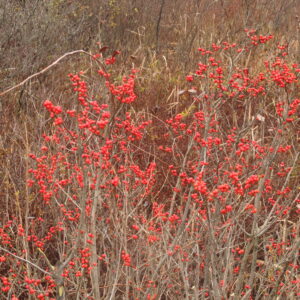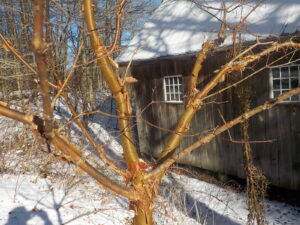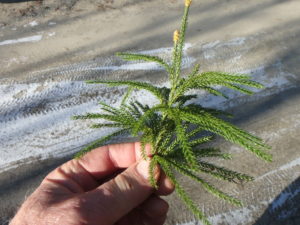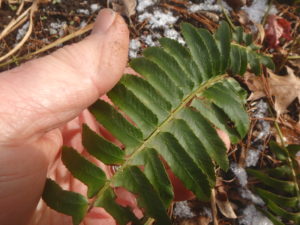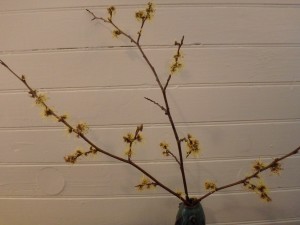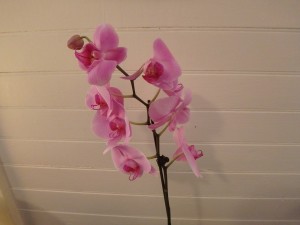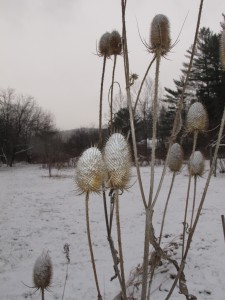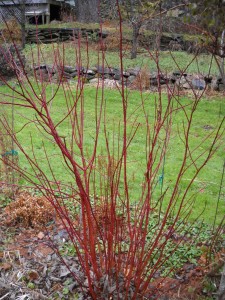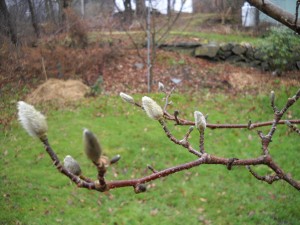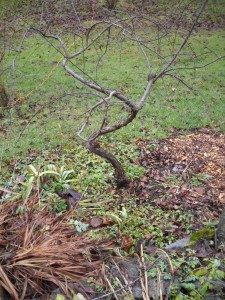Enjoying the Winter Landscape
Winterberry is a great decorative shrub in winter that prefers wet feet, but will grow in ordinary garden soil, too. It is dioecious, meaning that it requires male and female plants – usually one male will take care of all the females. This year I didn’t get many of those bright red berries I like so much for decoration, and I have heard from other gardeners that they had few, too.
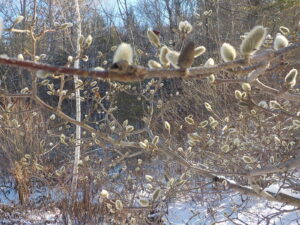 It struck me that winter can be pretty bleak for people who don’t have nice looking winter shrubs and trees. Judicious pruning can turn transform a messy tree full of small branches going every which way into sculpture. I recently helped a client prune a 50-year old Japanese maple into sculpture that will keep it looking great for several years – with only a few minor pruning cuts each year.
It struck me that winter can be pretty bleak for people who don’t have nice looking winter shrubs and trees. Judicious pruning can turn transform a messy tree full of small branches going every which way into sculpture. I recently helped a client prune a 50-year old Japanese maple into sculpture that will keep it looking great for several years – with only a few minor pruning cuts each year.I’ve been growing a paperbark maple (Acer griseum) for about 20 years. It has lovely shaggy reddish-brown bark that is very handsome. It is a very slow-growing tree, at least in this climate. It is listed as a Zone 5 plant (good to minus 20 F) but mine has survived colder temperatures. It looks great in winter
Five Plants for Adding Indoor Color
This is the dark time of the year. The sun sets early, and is often obscured by clouds dripping rain and snow. For that reason, I string bright lights on trees outdoors, decorate a tree indoors, place candles in my windows – and lots more. I buy cut flowers, too, but I can’t afford to buy armloads of bright flowers every week. Fortunately the outdoors provides me with many nice things to brighten my living space.
One of my favorite shrubs at this time of year is winterberry (Ilex verticillata). You may have seen the bright red berries of wild winterberry growing alongside the road in wet places, often in standing water. It favors wet places, but can be grown in the average garden. In the wild it is an understory shrub, one that grows in partial shade. It produces the most berries, however, in full sun.
As a landscape plant, the winterberry is best in fall and winter when the red berries are prominent. The spring blossoms are small and white, and hardly noticeable. These shrubs are either male or female, and you need one male for every 6 to 10 females within about a 50-foot range. So when you buy winterberry, plan on having several. Unlike puppies, you can’t lift a tail and know what sex you are buying, but have to depend on the nursery to label them properly.
When you bring cut branches into the house and place them in a vase of water you will notice that they regularly drop berries. There is a solution: spray with a clear lacquer. Last year I sprayed branches that I used on my door wreath, and for the first time ever, most berries stayed on until I took down the wreath. Previously some of the berries fell off every time the door was closed.
Evergreen boughs are commonly used for indoor arrangements, sprays, kissing balls and garlands. If you plan to harvest evergreen branches on your own property for this, be sure to use branches that will hold onto their needles. Balsam fir and spruce, commonly used for Christmas trees, hold onto their needles well even when not in a vase of water. But most of us don’t want to cut off branches if we have balsam or spruce on the property.
What most of us have growing in our woods are white pine and Canadian hemlock. White pines hold their needles, hemlocks do not. The hemlocks have short needles arranged flat along the stems; they have 2 white stripes on the underneath side of each needle. White pine needles are long and pointy, but soft. They grow in bundles of 5 needles (one for each letter in the word ‘white’).
Of the ferns you might see in the woods now, only the Christmas fern (Polystichum acrostichoides) is suitable for use in a vase. These have leathery green leaves with leaflets arranged in an alternating pattern. Some think the leaflets resemble a Christmas stocking, with a toe or heel at the end near its attachment point. I do not. I think they are called Christmas fern because they are still nice at Christmas and other ferns have largely disappeared by now.
Christmas ferns grow in shade or partial shade, and prefer somewhat moist locations. If you pick some, do not completely defoliate an individual plant. Take a few stems from one, and then a few from others. These plants are tough, but slow-growing.
What else is green and will do well indoors? Ground pine (Lycopodium obscurum) grows in deciduous forest in many of the same places as Christmas ferns. It is not a pine at all, but a club moss, a group of primitive plants that fed the dinosaurs when club mosses got to be 30 feet tall. These poor relatives only grow a few inches to a foot tall, but have handsome foliage in winter. They spread by rhizomes or roots. Each plant has leaves that come from the central spine of the plant, and lie parallel to the ground – like little Christmas trees. Please be judicious in picking these.
Back to the reds: red-twigged or redosier dogwood (Cornus sericea), a native of moist areas here in the Northeast, looks good in a vase. The color brightens up considerably in the winter, especially on this year’s growth. If the town road crew brush-hogged the roadside this summer, the new growth on red dogwood will be very bright.
Of course the plant nursery business has been working hard and breeding the reddest, brightest varieties and touting each of them as the very best. But all are good, and are very fast growing – especially in wet areas. I favor pruning out at least half the stems each year to get new stems with bright winter color, and have been known to cut a bush right to the ground.
So don’t feel bad if you can’t afford big vases of roses at this time of year. Get outside and pick some nice things that will brighten the house.
Read Henry’s blog at https://dailyuv.com/
Winter Color on the Table
I garden for many reasons. I want to grow my own chemical-free food, to have an excuse to be outside a few hours every day, and to have flowers on my table most of the year. Right now I have just 2 out of 3. A good batting average for a ball player – better than David Ortiz, for example – but not good enough for me. I want to hit one thousand. I need color and beauty in my house all year.
I almost always have a pair of pruners in my car, so when driving past an uninhabited swampy area recently I stopped to pick some winterberries. These red berries are the fruits of our native holly, Ilex verticillata. Unlike the evergreen varieties with shiny green leaves, winterberry drops its leaves in the fall, but clings to the red berries displayed on the female bushes.
Winterberry is dioecious, meaning that there are male and female bushes, and (remember that lecture you got ever so long ago about the birds and bees?) only the females produce fruit. And only if there are males present. If you buy winterberry plants, a good nursery will be sure to sell you a male to go along with your females. One male for 5 females is adequate.
Winterberry is a very satisfactory garden plant. It prefers moist soil and will grow in standing water – though I have seen it succeed in ordinary garden locations, though not in dry, sandy places. It does best in acidic soil, with a pH of 4.5 to 6.5, so add some sulfur to the planting hole. It produces the most berries in full sun. Soil rich in organic matter is a plus.
It is very cold hardy, surviving temperatures to minus 40 degrees (Zone 3). It is a moderate-sized shrub, rarely getting much more than 6 to 8 feet tall and 4 feet wide. I’m not sure why I haven’t planted much of it, as it brightens the winter landscape with its bright berries standing in contrast to the snow. Next year I will plant some more. Remind me!
Of my outdoor flowering plants, only witchhazel (Hamamelis virginiana) is still in bloom. Its yellow flowers have strap-like curly petals that remind me ever so slightly of yellow spiders dancing on the branches. The flowers are, theoretically, fragrant, but I have never noticed such.
Witchhazel will bloom in sun or shade and prefers moist soil. It has an open, branching habit. It is native to our area, and I first met it in the fall, hiking through a woods; I was intrigued to find something blooming after leaf drop, and looked it up. I have two that I planted, and after 10 years they are about 10 feet tall – but somewhat wispy. They are considered small trees or large shrubs and will grow up to 20 feet tall, but can be kept smaller with pruning.
My fallback position for color on the table is to visit my local florist on a regular basis for cut flowers. For 10 to 15 dollars I can get a nice arrangement of flowers that will last up to two weeks. Ask for flowers that will last a long time in an arrangement. Chrysanthemums are great, as are alstroemeria and carnations; lisianthus, spray roses, statice and monkey paws last well, too.
Each fall I also purchase an orchid. Orchids are thought by some as fussy or temperamental, but if you treat them right, they will bloom for months – and even come back and bloom the following year (though that is tougher). The most common orchids sold are Phalaenopsis orchids. Twenty years ago they were dreadfully expensive, but growers in Holland and Taiwan now produce them by cloning – producing hundreds of thousands of them for sale in big box stores.
Phalaenopsis orchids like bright light, but no direct sunshine. They do not do well with cold temperatures, but home temperatures are generally fine – even though they come from greenhouses with temperatures in the 80’s. Don’t place them near radiators, woodstoves or doors to the outside. And never let the roots sit in water!
When buying an orchid try to find one that not only has pleasing colors, but also has plenty of buds. The stems will blossom from bottom to top, but usually you will only get blossoms from existing buds. I have cut back flower stems part way to the base after blooming, and gotten side shoots that blossomed, but that is rare.
Because you can buy a Phalaenopsis orchid for $10 to $15, some people just toss them out after blooming. Not me. I keep them, watering once a week until summer, when I bring them outdoors onto my shady deck. They come in pots with no drainage holes and would drown and die if I left them in those pots, but I lift out the inner pot which is just a stiff plastic mesh, which allows rain to moisten the roots but not rot them.
This year I have 2 Phalaenopsis orchids that I bought last year, and one has started a flower stem. It hasn’t yet started forming buds and I know I will never get it to bloom as magnificently as it did when I bought it. Still, it will add some color in a couple of months – and it cost me nothing this year.
Most Americans waste money on unnecessary items from time to time. Me? I’d rather waste a little money on house plants and cut flowers than most other things.
Read Henry’s blog at https://dailyuv.com/
Holiday Decorations
This time of year is tough on many gardeners: there is little daylight and little to do in the garden. And there are no flowers to pick and place on the table. Recently the weather has been dismal: dark gray days with precipitation off and on. Over the centuries people have combated the darkness with candles, bonfires, holiday lights and sprigs of greenery placed on the door or brought inside. Let’s look at what we can do.
First, I regularly visit my local independent florist. Florists are a dying breed, along with independent bookstores and family-owned hardware stores. Call me an old codger, but I believe that there is value in supporting all of these institutions, even if I pay a dollar or two more for what I buy. The owners of these institutions have a wealth of knowledge, and are happy to help you find just what you need. And often their prices and quality are actually better.
For example, I believe that the flowers I get from my florist last longer and look better than flowers bought at a big box store. I ask my florist to put together a bouquet of flowers for me, and she picks a nice selection – $10 will usually buy a generous bouquet.
Keeping the bouquet fresh takes regular maintenance: I change the water every day or two, and trim off half an inch of stem each time. It’s also important to remove all leaves that might get into the water. When the leaves die, bacteria grow and slime forms – blocking the uptake of water to the flowers. So they wilt.
A few years ago I called my florist to see if she had any potted phalaenopsis orchids for sale. Surprisingly, she told me to go to a big box store, and I did. I was amazed to see them for sale under $15. Certain big box stores obviously have suppliers who sell them truck loads of these hardy and gorgeous orchids. So most florists don’t even try to compete.
Phalaenopsis orchids are relatively easy to maintain and can be coaxed to produce more blossoms in future years. They want bright diffuse light: a table top in a bright room is fine. The key is to avoid overwatering. These orchids are sold growing in a fast-draining bark mixture without soil. The roots are in a plastic mesh pot with holes which sits inside a ‘cache’ pot that has no drainage hole. I lift the inner pot out of the outer, and allow water to run through the bark chips once a week. I allow it to drain, then return it to the cache pot. If you water the plant in the outer pot, it collects water at the base – eventually drowning your orchid.
I also scavenge twigs, branches, dry flowers and berries to add to flower arrangements, or to create arrangements in their own right. Each fall I cut hydrangea blossoms and store them in tall flower pots without water. They last well all winter.
Teasel is a dreaded weed for corn farmers in the Midwest, but I grow a few plants each summer and use it as a dry flower in winter arrangements. This plant is biennial, meaning that it blooms in its second year of life, and then dies. It gets to be over 6 feet tall and displays wonderful seed pods that have sharp barbs and spines. The key is to learn to identify the first year plants, so that you can weed out most of them before they mature.
Evergreen boughs are nice indoors at this time of year. Just be careful where you make your cuts. Never take the top of a small tree, or the tip of a prominent branch. Most do not replace the missing branch, or will send out several new branches instead of just one. So you can spoil the look of your evergreen by snipping branches carelessly. Cut inner branches, or take pieces from inconspicuous places.
Canadian hemlock is plentiful in woods everywhere, but the needles do not last well indoors. (Identify them by their short, flat needles). Your best bet is to buy a Christmas tree that is a little too tall – and the cut off branches at the base to use in vases or swags. White pine lasts well in a vase and is very common (Identify them by their 5 long, soft needles per cluster of needles, one for each letter in w-h-i-t-e).
Of the berries, the brightest and best looking is winterberry (Ilex verticillata), our native deciduous holly. These are understory trees or tall shrubs that grow wild in wet places and swamps, but also make satisfactory garden plants. They are dioecious, which means you need a boy bush to go with the females – or no berries. The berries are commonly sold by florists and grocers, and look great – though they tend to drop a few berries on the table before long. I don’t know how to keep that from happening. (Tell me if you do, please).
Last but not least, I am cheered up by outdoor winter lights. In recent years the industry has come up with LED lights that use almost no electricity – less than 5 watts a string instead of the 5 watts a bulb we had in my youth. So I place them in my garden on trees and shrubs and run them late into the winter. It’s all part staying cheerful while living in the Great North.
Henry Homeyer lives in Cornish flat, NH. You may reach him through his web sites: www.henryhomeyer.com or www.Gardening-guy.com.



